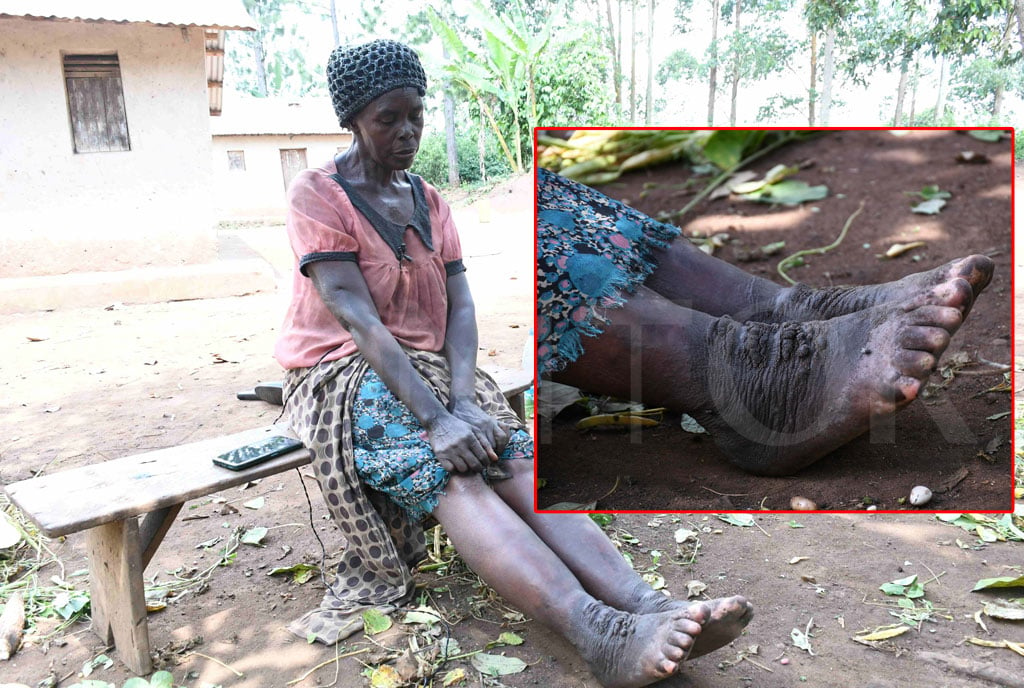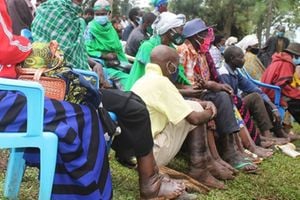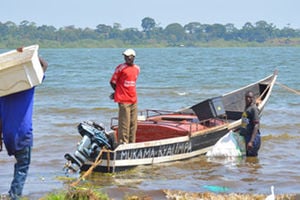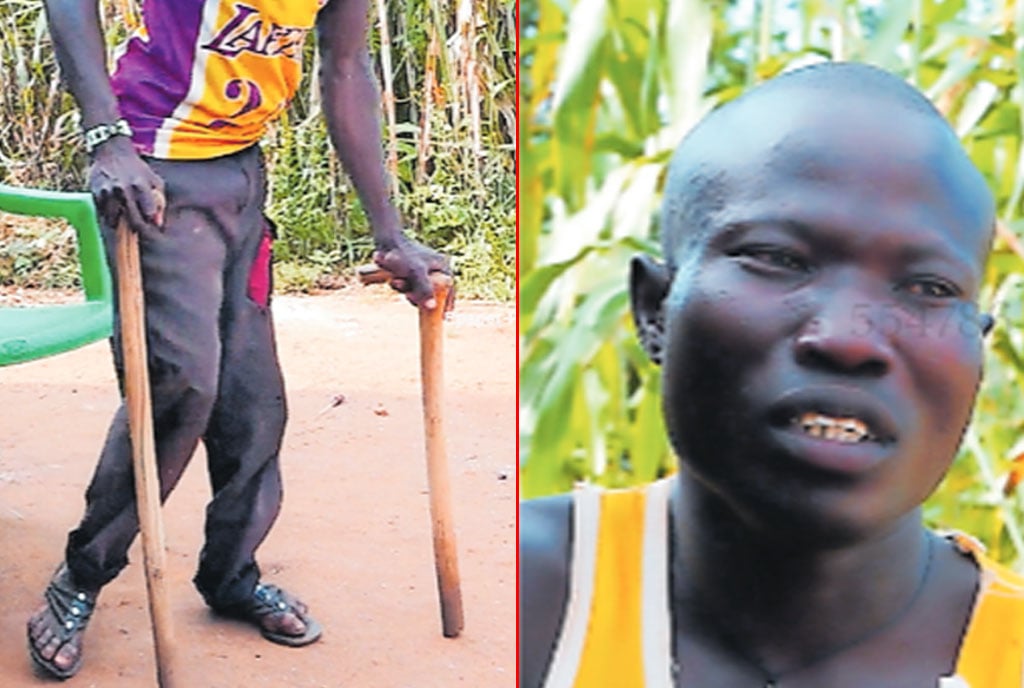
Ms Gaudesia Tankobatagira at her home in Kabigyemire village Busiriba sub-county showing how her legs were infected by elephantiasis. PHOTO/ALEX ASHABA
It is midday and Gaudensia Tankobatagira is sitting quietly on a stool beneath the shade of an avocado tree at her home in Kabigyemire Village, Busiriba Sub-county in Kamwenge District. Surrounded by her grandsons, the 63-year-old woman patiently shells beans.
Dressed in a simple gown, parts of Tankobatagira’s legs are covered with a piece of cloth. At first glance, there is nothing unusual about her. However, beneath that cloth lies a disease that has crippled her life.
Both her legs, from the knees to the feet, are severely swollen and damaged. Over the years, the skin has hardened. Her toes, too, are enlarged. She can barely walk around her compound.
"I have been sitting here since morning. This has been my daily routine since 1996. I cannot do my housework because my legs ache and itch. I can barely sleep at night,” Tankobatagira says.
She is just one of many residents in this remote community in Busiriba Sub-county afflicted by elephantiasis, a disease that causes extreme swelling and thickening of the skin, particularly in the legs.
A parasitic worm called wuchereria bancrofti, which is transmitted by mosquitoes, causes lymphatic filariasis, commonly known as elephantiasis, a disabling neglected tropical disease.
In 2002, Uganda launched a programme to eliminate elephantiasis (LFE) as a public health concern, with goals to alleviate physical, social and economic hardship in individuals who have LF-induced disability. According to the Ministry of Health, these goals have been achieved through interrupting transmission by deworming and disability management, community care and counselling.

Elephantiasis disease patients at a hospital in Kamwenge District. PHOTO/FILE/ALEX ASHABA
However, in August 2015, an elephantiasis cluster was discovered in Kamwenge District. A paper, Risk Factors for Podoconiosis: Kamwenge District, published in the National Library of Medicine, explains that this particular strain of elephantiasis (podoconiosis), is caused by walking barefoot on irritant volcanic soils in the district.
The debilitating disease is associated with high levels of disability, reduced productivity, and social stigma. Investigations by the World Health Organisation’s Uganda Country Office and the Vector Control Division of the Ministry of Health found that simple and inexpensive interventions can prevent foot exposure to irritant soils.
This includes washing the feet within two hours of contact with the soil and wearing protective footwear. However, these interventions were too late for Tankobatagira, whose struggle began three decades ago.
The genesis
In 1996, when she was 28 and pregnant with her second child, Tankobatagira's legs began to itch persistently. At the time, there were no health facilities near her home and she did not understand what was happening to her body.
“I started using herbs. I would tie them around my leg, hoping to get relief from the itching. At that time, no one had heard of this disease in Kamwenge. It did not occur to me to visit a hospital,” she says.
After a few months, her legs began swelling. She could not wear shoes, and as her condition worsened, the pain became unbearable.
“Sometimes, when the pain was too much, I would get a fever. Flies would follow me everywhere because my legs smelled. The skin on them turned rough. It was like I had thorns growing all over,” Tankobatagira adds.
Despite the unbearable pain, she continued with her daily chores for as long as she could.
“Over time, though, the swelling grew so severe that even walking became impossible. The pain was so bad that I had to crawl around like a child," she says.
For years, Tankobatagira was the only one in her household affected by the disease. She was incapacitated, and the open wounds on her legs made any movement unbearable.
“I do not know how I will manage as I grow older. I spend my days here, under this tree, waiting for the pain to pass, in vain. In 2011, a team of health workers came to the village to collect blood samples from the residents. They told me I was suffering from elephantiasis,” she adds.
By then, the smell of her rotting skin was unbearable. She was unable to attend church or any village functions.
“People stopped calling me by my name. They gave me a cruel nickname, Owemirumo, meaning, ‘the one with bad legs.’ It was a painful label, one that brought stigma into my life,” she laments.
It was in 2015 when she attended a meeting organised by a non-governmental organisation (NGO) that she discovered, to her surprise, that other people were suffering from the same disease.
Transmittable disease or not?
Elephantiasis has taken a toll on many in Kamwenge District, particularly in Busiriba Sub-county, where almost every village has people affected by the disease. Research shows that podoconiosis is not transmitted and neither is it a communicable disease. However, some of the cases raise eyebrows.

Legs of an elephantiasis disease patient are seen at Fort Portal Hospital on October 27, 2024. PHOTO/ALEX ASHABA.
In Kyakatooma village, 45-year-old Enid Twamusiima is another victim of elephantiasis. She recalls that in 2000, she noticed the signs of swelling in her legs. Like Tankobatagira, she tried using local herbs to alleviate the pain and swelling, in vain.
The mother of two says her mother and brothers also suffered from elephantiasis. All of them have since passed on.
"After my husband died, I moved back to my mother’s home, where we looked after each other. In the end, she also passed away," she says, her voice laden with sadness.
Twamusiima’s condition is worse than most because both her left leg and left arm are affected. Last month, an NGO brought her and three others to Kampala City for treatment.
“We were treated for a week before being referred to Rukunyu Hospital in Kamwenge District. My arm was operated on. The other two victims were told that the doctors would return in February next year to treat them,” she adds.
Twamusiima does not believe elephantiasis is harmless, despite what people say.
“They tell us that elephantiasis does not kill people, but I have already lost my mother and two brothers. They all suffered from the disease, and I believe it contributed to their deaths. When my arm was infected, I could not hold a hoe. My children sometimes go to the garden to dig when they leave school,” she says.

Elephantiasis patient Enid Twamusiima at her home in Kyakatooma village Busiriba sub-county displaying her infected legs during an interview with Monitor in October 2024. PHOTO/ALEX ASHABA
Twamusiima’s two children, aged 14 and 10, have started complaining of pain and itching in their legs.
“They say their legs hurt when they walk to school. I fear for them. It would be a tragedy if they also got infected,” she laments.
The remedies
Elephantiasis, particularly podoconiosis, is incurable. However, it can be treated and prevented. Improving hygiene, surgery and counselling are some of the remedies available to people suffering from elephantiasis.
When Tankobatagira met with other sufferers, she was advised that she needed to elevate her hygiene levels.
“We were told to wash our legs three to five times a day and avoid direct contact with the soil. The doctors also advised me to elevate my legs when sitting, avoid folding them, and swing them often to help with blood circulation. These small changes have helped,” she says.
She adds that swelling of her legs began reducing to the point that she would wear gumboots, though finding a pair that could fit her was a challenge.
“She wears size 11. The Prime Minister once gave her a soft pair of gumboots that fit well, but when they tore, it took us two months to find a replacement. We searched everywhere, from Kamwenge Town to Fort Portal City, but could not find anything suitable. We eventually ordered a pair from Kampala at Shs30,000, but it was not a good fit,” Baker Musinguzi, her son, recalls.
In September 2021, Prime Minister Robinah Nabbanja, accompanied by a team of doctors, visited Busiriba Sub-county and donated gumboots, salt, and a small amount of money between Shs40,000 to Shs100,000 for upkeep to the victims.
Dr Patrick Tusiime, the commissioner for Communicable Diseases, Prevention and Control, who accompanied the Prime Minister, informed the patients that the disease is linked to silicon minerals found in the soil.
“Currently, health workers can only manage the symptoms. You should avoid regular contact with the silicon and aluminum in the soil. Patients need to wear gumboots and shoes at all times,” he said at the time.
Today, Tankobatagira operates a small poultry farm at home. She sells the chicken to buy medicine and other necessities.
“Every day, I wash my legs with water and salt. I pour five cups of water into a basin, mix some salt into it, and then, soak my legs for about 10 minutes. After that, I smear them with petroleum jelly and wear the gumboots to keep the skin soft," She said.
Forgotten victims
Everest Beyanga, a resident of Busiriba Sub-county, is the focal person for elephantiasis patients in Kamwenge District. He is a volunteer, though. He says the disease was discovered in 2011 in the district when he was working with Ride Africa, an NGO based in Fort Portal City.
“We were conducting routine monitoring of health services when we encountered a marginalised group of individuals who had not received medical attention for years. We identified 32 elderly people suffering from swollen feet and who had a foul odour,” he says.
He explains that there was a community's misconception that these people had been bewitched. Others thought it was a disease caused by elephants because their village borders Kibale National Park.
The NGO sent a report to the Ministry of Health, which conducted research and took samples from those affected. The results revealed that these individuals were indeed suffering from elephantiasis.
“Many people were reluctant to disclose their situation for fear of being discriminated against. We discovered many hiding in their homes. Others had died. I have 600 victims recorded but I estimate there are more than 1,200 in the entire district,” Beyanga says.
He adds that the disease is more common among women and the youth. Since 2011, he has recorded 46 deaths attributed to elephantiasis.
“Many of these individuals die because they do not seek medical help due to stigma. Others come from impoverished families that cannot afford basic hygiene care. Some people’s legs are rotting and they never leave their homes. I am often the only person who sees them,” Beyanga says.
Over the years, Beyanga has dedicated himself to organising health camps and connecting people suffering from elephantiasis to various organisations for help.
“Other categories of people, especially those living with Aids or cancer, receive special care and attention. But these people have been forgotten. Even health workers call me when they encounter these patients at their facilities, asking me to come and see them," he says.
Nowadays, in the absence of formal aid, many of the victims, like Twamusiima, have resorted to self-medication, getting the drugs from shops in their villages.
“Whenever I get severe pain, I send for panadol, ibuprofen, or diclofenac gel,” she says.
Beyanga is concerned about the effectiveness of the different painkillers used.
“The drug shop owners are just making money off these people’s plight. They may give anything that relieves pain but it does not address the root cause of the disease. I request the government to retrain health workers on proper management of elephantiasis,” he cautions.
Beyanga adds that unlike in the past, the disease is now spreading to other sub-counties such as Bigodi, Kababiro, Rwamwanja, and Kahunge.
“The mode of transmission remains a mystery. We need more research about it. In most families, only one person is infected while the others remain healthy. Recently, though, we are seeing young children developing the condition, including a five-year-old girl from Nyabubale village in Bigodi sub-county," he says.

Nebukaduneza Mugabe, 50, the village chairman of Lyamugonera in Kahunge Town Council, Kamwenge District removes a bandage to display his elephantiasis infected leg during an interview with Monitor in October 2024. PHOTO/ALEX ASHABA
Nebukaduneza Mugabe, the chairperson of Lyamugonera village in Kahunge Town Council, has been battling elephantiasis since 2015. At the time contracted the disease, he was serving as the Internal Security Officer (GISO). In 2021, he was dismissed because the disease had incapacitated him.
“Since I had some money, I visited several hospitals. I spent Shs1.3m at Mbarara Regional Referral Hospital, Shs700,000 at Kilembe Hospital, Shs1m at Mbale Regional Referral Hospital, and recently, Shs200,000 at Bugema University Hospital. But nothing worked. I eventually gave up,” he says.
Mugabe’s legs are too swollen to fit in gumboots and they spot wounds that refuse to heal. Instead he wraps bandages around them and covers them with kaveera (polythene bags). He uses a walking stick to get around.
“It is painful to watch my family struggle when I should be the one providing for them. Two of my children have started complaining about itching in their legs. They are beginning to swell and I fear they are infected too," he laments.
In February, next year, Mugaba will be one of the victims who will be operated on at Bugema University Hospital.
Government response
When Prime Minister Robinah Nabbanja visited the area, she pledged that the government would elevate Busiriba Health Centre II.

Prime Minister Robinah Nabbanja gives money to people battling elephantiasis disease at Busiriba health Center II in Kamwenge District in September 2021. PHOTO/ALEX ASHABA.
However, today, only the outpatient department is under construction. “The government should establish a specialised unit at Busiriba Health Centre II for elephantiasis patients. These people need dedicated care and counselling. It is time that the government stopped neglecting them,” Beyanga says.
Dr William Mucunguzi, the district health officer for Kamwenge, declined to be interviewed on the challenges faced by people suffering from elephantiasis.
He stated that with the 2026 general elections approaching, this story could be politicised. Dr Mucunguzi added that the situation in Busiriba Sub-county was calm and, in his view, there was no story to report.







